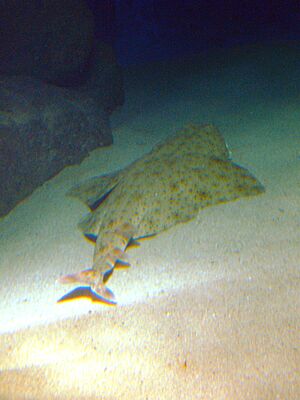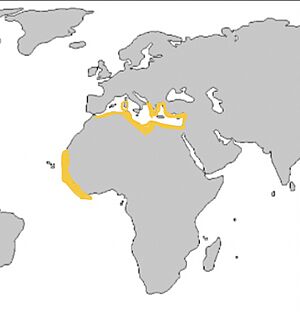Sawback angelshark facts for kids
Quick facts for kids Sawback angelshark |
|
|---|---|
 |
|
| Conservation status | |
| Scientific classification | |
| Genus: |
Squatina
|
| Species: |
aculeata
|
 |
|
| Range of sawback angelshark (in gold) | |
The sawback angelshark (Squatina aculeata) is a special type of angelshark. It belongs to the Squatinidae family. This shark is one of the rarest sharks known today. It's also one of only three angelshark species found in the Mediterranean Sea. Sawback angelsharks like to live on sandy and muddy parts of the ocean floor. They can be found deep down, from about 30 to 500 meters.
Contents
How Big Are They?
When sawback angelsharks are born, they are about 30 to 35 centimeters long. That's about the length of a school ruler!
Adult female sharks grow bigger than males. Females can be about 137 to 143 centimeters long. Males are a bit smaller, usually 120 to 122 centimeters long.
Males weigh between 12.7 and 24 kilograms. Females are heavier, weighing from 22 to 32 kilograms. Females need to be larger to carry and support their young.
What Do They Look Like?
The sawback angelshark has eyes that are larger than its spiracles. Spiracles are like small openings behind their eyes that help them breathe.
They have special flaps near their nose that are fringed. Their spiracles have many small parts inside, like gills.
These sharks have between 19 and 24 teeth. Most of them have about 21 teeth in total.
Their bodies are covered in small, rough scales called denticles. On their back, they have large, pyramid-shaped denticles. There's also a line of spines down the middle of their back. Their belly is mostly smooth, but they have denticles on the edges of their fins.
They also have large thorns on top of their head, which continue in a row down their back.
The sawback angelshark is light brown with darker brown spots. It also has white spots on its head and parts of its body. You might see dark blotches on its head, back, fins, and tail.
Where Do They Live?
The number of sawback angelsharks is getting smaller. This means their living areas are shrinking too.
They can be found in the Eastern Atlantic Ocean, near countries like Senegal, Gambia, and Sierra Leone.
They also live along the southern coast of the Mediterranean Sea, from Algeria to the eastern side. On the northern coast, they might be found from Turkey to Albania.
These sharks prefer warm, subtropical waters. They live offshore, on the outer parts of the continental shelf and upper slopes. They are usually found on muddy ocean bottoms.
How Do They Behave?
Just like other angelsharks, the sawback angelshark spends its time on the ocean floor. It's a master of disguise!
It tries to blend in with the sand or mud. This way, it can hide and wait for its prey to swim by. Then, it can quickly ambush and catch its meal.
What Do They Eat?
Sawback angelsharks are "ambush predators." This means they don't chase their food. Instead, they lie still on the ocean floor and wait.
When a smaller animal swims close enough, the shark quickly attacks. They eat small sharks, bony fish, squid (cephalopods), and crabs or shrimp (crustaceans).
Reproduction and Life Cycle
Sawback angelsharks reproduce in a special way called ovoviviparous. This means the baby sharks develop inside eggs, but the eggs stay inside the mother's body until they are ready to hatch. The mother then gives birth to live young.
On average, a sawback angelshark generation lasts about 15 years. This means it takes a long time for their population to grow.
Female sharks usually have a litter of 8 to 12 pups at a time. Larger female sharks tend to have more babies than smaller ones.
Why Are They in Danger?
The sawback angelshark is listed as Critically Endangered by the IUCN Red List. This means they are at a very high risk of disappearing forever. They were added to this list in 2007.
One big reason for their decline is too much fishing. People have caught too many of them, sometimes by accident. This includes illegal fishing and commercial fishing where sharks are caught without being properly identified.
Another major problem is pollution in the North-Eastern Mediterranean Sea. Waste from farms, factories, and cities has put harmful metals into the water. These metals, like Iron, Zinc, and Mercury, have been found in dangerous amounts inside the sharks' bodies.
Human activities also disturb their homes and breeding areas. Building along the coast and developing new energy sources like underwater turbines can harm their habitat. All these things together have led to fewer sawback angelsharks and less variety in their genes.
Are They Dangerous to Humans?
The sawback angelshark is generally a harmless species. They are not known to attack humans. However, like any wild animal, they might become dangerous if they feel threatened or if their home is disturbed. It's always best to observe them from a distance.


